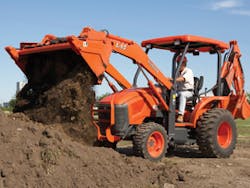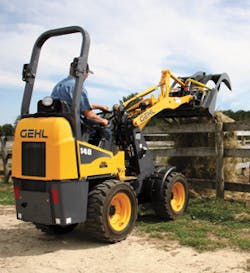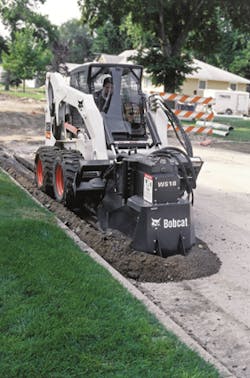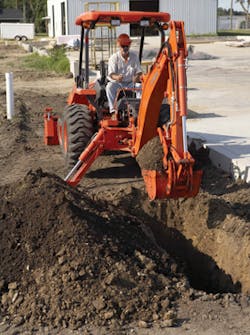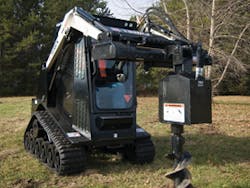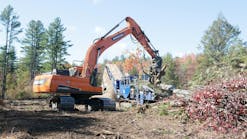At one time, if you were a grading and excavating contractor looking for a loader with the ability to work quickly, efficiently, and productively on job sites where both time and maneuver room were in short supply, you were limited to a skid-steer machine. Now, of course, your choices of compact loaders also include those with rubber-track undercarriages, wheel machines with articulating frames, and rubber-tired tractors equipped with lift arms and a bucket on one end and a backhoe on the other.
All are designed to help you make the most of money-making opportunities when working in confined areas. However, each is designed to handle certain of types of jobs and site conditions better than any of the others.
For example, with its ability to turn completely around within its own length, a skid-steer loader offers the ultimate in space and time-saving maneuverability. Also, it offers the widest assortment of attachments than any other type of compact loaders. That makes it the most versatile choice in terms of the types of work it can perform. Like a skid-steer loader, a compact track loader can also turn 360 degrees in place, if necessary. But, this machine’s real strength lies in its tracks. They give this type of loader much more flotation and far better traction to keep working in soil and terrain conditions that would stop a skid-steer or other type of wheel loader. One advantage of a compact articulated wheel loader, on the other hand, is the ability to maneuver easily on pavement and other hard surfaces with much less wear on tires than skid-steer loaders would suffer. Meanwhile, a compact tractor-loader-backhoe combines the ability to lift, carry and load materials with the ability to handle trenching and other digging jobs in a single unit.
Because of their speed, agility and versatility in tight quarters, compact loaders have proven especially popular for residential applications where building lots have continued to shrink in size. Consequently, the recession of the last two years or so, has been especially hard on grading and excavation contractors who serve this market, not to mention sales of these machines.
Bob Beesley is a product manager for Komatsu, whose line of construction equipment includes both skid-steer and compact track loaders. A 30-year veteran of the compact construction equipment industry, Beesley offers this assessment of the current market for these types of products.
“Manufacturers of compact construction equipment live and die by housing starts, which have fallen dramatically,” he says. “I’ve never seen residential construction activity this bad. At least things seem to have stabilized. There’s been a gradual increase in new home construction over the past few months. We haven’t seen enough consistent growth to say the recession is over. But, we’re beginning to see some signs of recovery.”
Assuming that business does, indeed, begin picking up for grading and excavation contractors in the not-too-distant future, now would be an ideal time to start planning for your equipment needs and buying decisions. Here’s a look at some of your compact loader options and how they could pay off for you.
The Right Match
They key to getting your money’s worth from any type of compact loader is choosing the one that offers the performance capabilities that best match your particular applications-how you’ll be putting the machine to work.
As an example, Beesley sizes up factors to consider when choosing between two types of machines-skid-steer loaders and compact track loaders.
For a given size, the costs to buy and operate a skid-steer loader are typically much less than for a compact track loader, he notes. “A compact track loader will do just about anything a skid-steer loader can, but the track machine will cost you more,” Beesley says.
Consider the money you’d spend replacing a set of tracks compared with replacing a set of tires. Four new tires for a skid-steer loader cost around $500, while the price of new set of rubber tracks for a compact track loader may run as high as $5,000 to $6,000. Operating a compact track loader on pavement, hard-packed ground, or gravel can add even more to your costs by shortening the rubber track life significantly. For example, even when operated correctly in proper applications, a set of tracks usually don’t last much longer than two sets of the tires, Beesley notes. “The reason is that so much more of a track stays in contact with the ground than a tire,” he says. “It’s amazing how little true contact there is between a tire and the ground.”
The undercarriage itself adds to the purchase price and operating expenses of a compact track loader.
“Manufacturers sell more skid-steer loaders than compact track loaders,” Beesley says. “In fact, when compact track loaders first came onto the market, people were predicting the end of the reign of skid-steer loaders. Many contractors bought compact loaders, even though they didn’t need them. Before long, they realized the track loaders were not cost efficient in their operation. So, they began trading them back in for skid-steer loaders. Today, the market for the two types of loaders has steadied itself.”
A skid-steer loader, Beesley adds, can handle about 75% of the jobs out there. A compact track loader, on the other hand, does everything a skid-steer loader will do. Plus, it can tackle the remaining 25% of the jobs due to the greatly increased flotation and traction, which can justify the extra cost of a compact track loader.
“By distributing the machine’s weight over a much greater surface compared to tires, the track-equipped loader exerts much less ground pressure, allowing the machine to travel across turf without causing ruts or tearing it up as a skid-steer loader would,” Beesley says. “Also, the much greater tractive effort of a track loader lets you keep pushing into a pile of dirt when working on a slippery surface where a skid steer loader would be spinning its wheels.”
Comparing Performance
For prospective buyers of skid-steer or compact track loaders, he suggests clearly understanding the strengths of each. “Have a good picture of the machine’s intended work environment before deciding which machine will be best suited to your purposes,” Beesley says. That advice holds when comparing other comparing loaders, too.
Skid-steer versus compact track loaders– In general, a skid-steer loader can do lift-and-carry work on firm, flat ground faster and more efficiently than a compact track loader, which, because of its increased traction and flotation, is a better choice for grading and excavating applications. Because it weighs more than a skid-steer loader of the same size, a compact track loader has a little higher tipping load.
Incidentally, manufacturers measure a skid-steer loader’s rated operating capacity at 50% of the machine’s tipping load. Usually, the rated operating capacity of a compact track loader is figured at either 35% or 50% of the tipping load.
Depending on make and model, both types of loaders offer either of two types of lift paths. A radial lift path raises and lowers the bucket in an arc, as viewed from the side. This provides the most reach at the midpoint of the lift height, making it a good choice for loading and unloading flatbed trucks. Also, it is a more durable design for grading, digging, trenching, and backfilling work. A vertical lift path, which raises and lowers the bucket straight up and down, has the greatest reach at maximum lift height for easier loading into dump trucks. In addition, this design allows the loader to lift more than a similar size machine with a radius lift path.
Compact Articulated Wheel Loaders– With top travel speeds of 20 mph or more, depending on make and model, a compact articulated wheel loader can easily outrun a skid-steer loader to save more time on jobs with long carry distances. In addition to a high dump clearance, it can lift and carry heavier loads than most skid-steer machines. While it requires more room for turning, a compact wheel loader doesn’t damage turf or finished surfaces as a skid-steer machine does when maneuvering. Unlike a skid-steer loader, which requires you to step over a bucket to reach the operator’s seat, a compact wheel loader features side entry and exit. Because it uses a steering wheel, it is easier to operate than a skid-steer loader, which uses hand controls for maneuvering. Also, you sit much higher in a compact wheel loader for a better view of the job site. That, of course, means less overhead clearance than a skid-steer loader offers. Other compact articulated loader features typically include two-speed hydrostatic drive, skid-steer loader-style couplers for use with a wide range of attachments, multifunction joysticks for controlling the lift arms and bucket, an inching pedal for more precise control at lower ground speeds, and oscillating frame for stability and operator comfort
Compact Tractor-Loader-Backhoe– Featuring digging depths from about 7 feet to 12 feet or so, lift capacities of a ton or more, along with the ability to load into dump trucks, depending on make and model, compact tractor-loader-backhoes are designed for serious work on smaller job sites. Whether hauling gravel, sand or other construction materials or digging through clay soils to excavate utility trenches, they can tackle the same types of jobs as their bigger brothers. That’s not all. Equipped with a PTO and three-point hitch on the rear, compact tractor loader backhoes can also take on a wide range of other jobs by using various types of implements and attachments, such as augers, box scrapers, mowers, rotor tillers, rear blades, and snow blowers. These machines also offer contractors just starting out a cost-effective, multipurpose alternative to other types of compact equipment.
The following case studies describe how owners of these various types of compact loaders are using them to whip challenging projects down to size. While their specific job sites and applications may differ from yours, their experiences can spark an idea or two on how you can profit from these versatile machines.This machine, a Gehl model 140, is one of Stanczyk’s two compact articulated loaders. The other is another Gehl product, a smaller AL 20 that he bought in the mid-1990s. Among the features he likes about these machines is their short, turf-friendly turning radius. The model 140, for example, has an articulated steering angle up to 45 degrees in either direction, and has a minimum turn radius of just under 8 feet, 4 inches, for maneuvering in tight quarters. Plus, he notes, it minimizes any surface damage when making turns on grass or sensitive pavement. The compact size is another advantage. “We can drive either model through gates no wider than 4 feet, and we can transport them on trailer pulled by a pickup truck,” he says. And, when working in areas with a low overhead clearance, he can fold the roll bar down to reduce the height of the machine to less than 74 inches. What’s more, the chassis oscillates ten degrees in either direction to maintain traction on uneven terrain.
Equipped with a 23-horsepower diesel engine, the model 140 gives Stanczyk the performance he needs to handle heavier jobs than his smaller articulated loader. That includes a 106½-inch lift height, for loading salt into dump trucks during snow removal operations in parking lots and driveways. The 960-pound rated operating capacity of this model allows him to handle a variety of material handling jobs. For example, it makes easy work of carrying and dumping bricks into trucks as part of an ongoing project to remove brick walls separating apartment patios.
Construction work for the machine includes a recent drainage project to install about 500 feet of pipe that ties into a manhole at one end. Here, the loader proved handy for hauling in pea gravel and hauling away mud excavated from the trench. The model 140 also makes quick work of digging jobs, such as excavating sewer and water lines. “It used to take several guys half a day to dig down and around an irrigation main to make repairs,” Stanczyk says. “Now, one operator using the machine with a bucket can to do the job in an hour or less.”
The model 140 is also equipped with a self-leveling feature that keeps the bucket horizontal as the lift arms are raised and lowered. “This eliminates the spillage that can occur when you try to keep the bucket level by continually adjusting the tilt using the hand controls,” he notes.
Skid-Steer Loader Proves Its Value When he began his own construction business a decade ago, Jay Williams of Peoria, IL, drew on his 25 years of experience as a concrete contractor in selecting his equipment. He chose a skid-steer loader—a Bobcat vertical lift S250 model—which he bought new. It features a rated operating capacity (35% of tippling load) of 2,500 pounds and an optional high hydraulic flow of 37 gallons per minute to run hydraulically powered attachments. In addition to providing the necessary power, this compact loader offered him the maneuverability and the versatility he wanted.“It’s the perfect machine for what I do,” he says. “I can load into dump trucks and tubs on tractor-trailer units, and, because of all the attachments I have for it, there are so many things I can do with the loader.”His business, Jay Williams Co., provides services for a large asphalt contracting company that does milling and overlay work on highways, streets, and parking lots.
Since starting with a standard, smooth-edge, 80-inch bucket and a 14-inch planer, Williams has continued to add to his list of attachments for his skid-steer loader. “When I pull onto a job site with my loader, it’s like up showing up with three or four separate, specialized machines,” he says.
Williams uses the planer attachment to mill butt joints, cut patches out of roads and parking lots and to trim things up after larger milling machines. One use of the bucket is to pick and load piles of millings left by these bigger units. Williams can also tilt either side of the bucket up or down. “That way I can use one corner of the bucket to peel out a 2-inch-by-2-inch wedge alongside a curb, so that the larger milling machine can work right up to the edge of curb without damaging the surface,” he says.
The bucket-tilt feature comes in handy for preparing parking lots for the asphalt pavement, too. “It lets me place gravel right into corners and on grade so that laborers don’t to have to shovel it,” Williams says. “I also use the bucket to put gravel right on grade next to the curb where the blade of a motor grader can’t reach when spreading the gravel.”
Once the large milling machine is finished, he cleans up the site to prepare the asphalt for priming using a sweeper attachment. The box-like, two-part unit has a rotary brush on the front that sweeps milling debris into a covered bucket. When the bucket is full, Williams lifts the attachment to empty the millings into a dump truck.
Should the work site have a wet area, he uses a sod disk to work lime about 12 inches or so into the soil to stabilize it for the overlay.
He takes a hydraulic breaker attachment with him on road projects to remove reflective lane markers, which are glued in place. “I hit them once with the breaker point and they pop right out,” Williams. “At one time, they tried doing this with a motor grader blade. However, it dug too deep into the road surface, leaving a depression that had to be re-blacktopped.”
On parking lot projects, he uses his skid-steer loader with an auger attachment to drill holes for installing protective bollards in front of building entrances.
Another time-saving attachment is clamshell unit with a spear point, Williams uses it to remove sections of concrete curbs, sometimes as long as about 20 feet, which he loads into dump trucks. Other times, when trees are removed from project sites, he mounts a grapple bucket on his loader to pick up and load logs and limbs into trucks.
The versatility and productivity of Williams’ compact loader and attachments hasn’t gone unnoticed by crews with the blacktop contractor. “When I started working with them, they were using a full-size tractor loader backhoe and sweeper trucks to clean up after the milling machines,” Williams says. “Once they saw what I could do with my equipment, eight other private contractors with the blacktop company bought skid-steer loaders and contracted with the company to do work just like me.”
Williams’ skid-steer loader is the same one he started with 10 years ago. Since then, the hour meter has rolled past the 6,000 figure. “I haven’t had a breakdown in five years, and it still runs like new,” he says. Undoubtedly, his daily maintenance program has contributed much to that kind of reliability. He spends about 15 minutes a day greasing all the fittings, checking and cleaning air and fuel filters and replacing them as needed. Following manufacturer recommendations, he makes sure to change engine oil every 100 to 150 hours. “I get to work about an hour early, to make sure everything on the loader is up to snuff before we head out to the job,” Williams says.
Compact Tractor-Loader-Backhoe Makes Sense for Elbow Room Based in the Pacific Northwest, Birch Equipment serves an equipment rental market that covers a 6,000 mile spread from one end to the other. “Our company offers a very large and very diverse selection of tools and machines,” says Jordan Mellich, manager of the company’s store in Bellingham, WA. “This equipment ranges from wallpaper steamers for homeowners to 80,000-pound excavators for construction companies.”The selection at his store includes a compact tractor-loader-backhoe or TLB—a 21-horsepower, four-wheel drive Kubota B21 model. Typically, it is rented by contractors, who represent about 60% of the store’s customers, Mellich reports.Uses for the machine include landscaping, material handling, trenching and various light construction work, he reports.
“This machine is a good choice for contractors who need to move dirt, dig ditches, or both on tight job sites,” Mellich says.” Also, if you’re doing a smaller excavation, like digging a trench for a 4-inch water line, it makes a lot more sense to use a compact machine like this one, than to bring in a full-size tractor-loader-backhoe with a wider bucket.”
Besides its ability to work efficiently when space for maneuvering is limited, a compact TLB is a versatile piece of equipment, he notes. “In addition to using the rear backhoe to excavate a trench, you can use the front loader bucket to bring in drainage rock, if needed. Also, you can remove the backhoe and attachment implements, like a box scraper, rototiller, or field mower to handle other types of work.
The machine’s productivity isn’t the only feature his customers find useful. “They also like ergonomic features, such as the ease of getting on and off the tractor, which improves operator efficiency by reducing fatigue, and the ability to change the direction of the seat between loader and backhoe operation just by lifting the seat up and turning it, Mellich says. “The hydrostatic drive adds to the convenience of operating the unit.”
Before renting any piece of equipment, he advises contractors to ask questions. For instance, if you’re unfamiliar with the product, find out how well the machine is suited to the type of job you’ll be using it for and how to operate it efficiently and safely. Check the manufacturer’s reputation. “Also, ask about the maintenance schedule,” he says. “You want a reliable machine. In the rental business there’s nothing worse than having a piece of equipment break down on your job site. In our store, for example, we don’t bring in any line of equipment until we do extensive research on the product and manufacturer. Our shop people are highly involved in making our purchase decisions to make sure a machine will do the job it’s designed for and is reliable.”
As with many grading and excavation contractors throughout the country, rental activity at his store has slowed considerably in the last few years, Mellich says. “The past couple of years have been tough,” he admits.
“We’ve been fortunate in not having to lay off employees, even though our work force is about 25% larger than needed for today’s market. We’ve got good people, and we’re continuing to invest time and dollars in new equipment and technology. But the Northwest has lagged behind the rest of the country, and we’re hoping we’ve all seen the worst for the Northwest now in 2010.”
Compact Track Loaders Help Develop a New Market When it comes to running a successful grading and excavation business, it pays to develop a specialty, says Shane Weleske. In his case, that’s the ability to work quickly, efficiently, and profitably in confined spaces.Shane and his father, Tom, own Weleske Improvements in Hallock, MN. Tom, 77 years old, started the company in 1956 and is still active in the day-to-day operations. “In many areas of the country, the construction business has been tough the last few years,” Shane says. “But, we’ve stayed busy. The farm economy, which accounts for about half of our work, has been strong. When those jobs have slowed, we’ve been able to pick up commercial, municipal or residential work.”He credits that versatility to his fleet of equipment, which includes a dozen or so major pieces of equipment, not counting a tandem dump truck and a pickup. Among them are two Terex ASV compact rubber track loaders—a 34-horsepower model PT-30 with a 560-pound rated operating capacity (35% of tipping load) and a model PT-100, powered by a 100-horsepower engine, with a rated operating capacity (35% of tipping load) of 2,660 pounds.
Site development represents about half of the company’s business, while utility repair and maintenance for residential, commercial, and municipal customers accounts for the rest. Some of the work in the wide-open spaces involves the use of big equipment to dig trenches as long as 2 miles for rural water utility customers. Jobs with limited room for operating construction equipment, on the other hand, range from backyard grading projects to interior demolition jobs and snow removal. That’s where the two compact track loaders earn their keep. “We get into a lot of confined space work,” Shane adds.
He was introduced to the value of compact equipment more than 20 years ago when he rented a compact excavator to replace hand shovels in digging footings for a home addition project. “We deal with a lot of heavy, tough clays,” he says. “When you’re digging in that stuff by hand, the first shovelful stays with you all day. We quickly discovered that the excavator could replace all that hard work. We ended up buying the machine. Once we saw how much work it could do, we had no trouble finding jobs for it. It opened up a whole new market for us. Soon, we were getting calls from many miles away.”
Today, in addition to two Terex compact excavators, a model TC29 and a model TC75, and the two compact track loaders, the company owns a Caterpillar 226 skid-steer loader, which is used for working on hard surfaces. This assortment of machines enables the company to handle just about any type of job where working room is tight.
Shane learned the value of compact track loaders when he bought his first one in 1991. It provided the traction needed to work on slippery clay surfaces and the flotation to operate in wet, soft conditions that would stop a skid-steer loader. Ten years later he traded in that machine in for his first ASV compact track loader, an RC-30 model. In 2004, Shane added an ASV model RC-100. Last fall, he traded both of them for his two current models.
“The compact track loaders added about a month of extra time to our construction season,” Shane says. “Plus, we can use them in winter for snow removal. Our PT-30 fits in very well with water and sewer line repair projects, and the PT-100 has the performance for heavy grading and snow-removal work.”
His crew hauls the machines to job sites on a gooseneck trailer pulled by a 1.25-ton truck.
Sometimes, both machines are used on the same job. This past spring, for example, they were put to work replacing a concrete floor in the basement of a hospital. The small loader carried debris outside the building, where the large loader picked it up and dumped the material into trucks, which hauled it away.
Various attachments add to the versatility of the compact loaders. They include a 4-foot wide utility bucket for the PT-30 and a 6-foot utility bucket and an 8-foot snow bucket for the PT–100. Each machine also has its own hydraulic breaker attachment hammer for jobs like tearing out or replacing a concrete sidewalk. The smaller machine also uses this attachment for demolition jobs inside a building. Among the other attachments is an auger for drilling holes for posts when erecting farm buildings or for foundation piers and pallet forks for unloading and carrying materials, such as shop supplies or pipes.
Last winter, Shane installed a rear-view camera on the top of his larger compact track loader. The viewing screen is mounted on the panel in front of the machine’s left joystick. “We did this to make snow removal work easier at night,” he says. “It works our well for us.”
Operators are responsible for daily maintenance of the compact track loaders as well as the other equipment. For the two loaders, this includes a visual inspection, checking all fluids, greasing and, if necessary, adjusting track tension,
One of the features Shane especially likes about these two machines is the ease of servicing them. “All the grease zerks are exposed and easy to get to and when you open the hood, all the service are right there,” he says. “When these things are easy to reach, people will check them.”
Proper operation of the compact track loaders also helps reduce maintenance expenses, he notes. “Some people complain that tracks are expensive to maintain,” Shane says. “But a lot depends on how you operate the machine to get the most for your money. We Y-turn the machines when possible, rather than spinning them around which is hard on the undercarriage and the tracks. Also, we keep these loaders out of rocks and concrete rubble.”
More information on Terex ASV compact track loaders is available at www.asvi.com.
